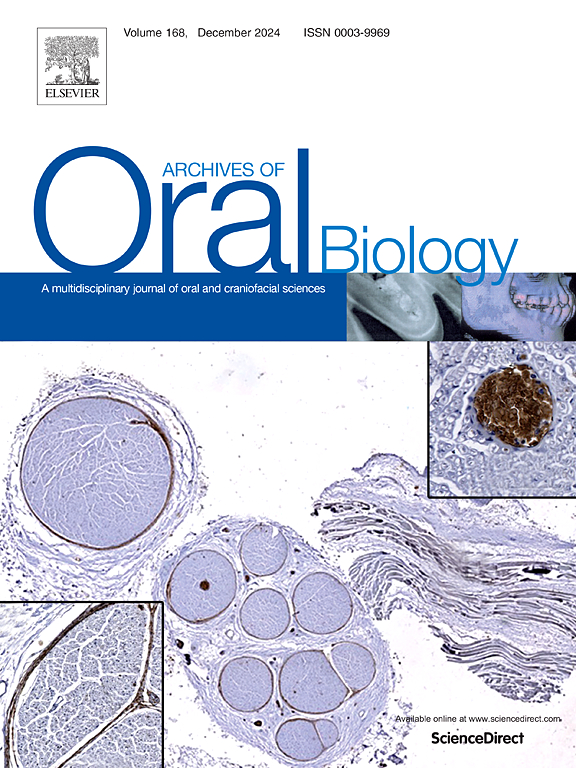口腔微生态群落-变形链球菌生态失调及其相互作用为龋病的治疗提供了新的思路
IF 2.1
4区 医学
Q2 DENTISTRY, ORAL SURGERY & MEDICINE
引用次数: 0
摘要
目的本文旨在综述变形链球菌(S. mutans)与其他链球菌、细孔菌、乳杆菌和白色念珠菌在口腔内的生态失调和相互作用,这是导致龋齿的主要原因。在PubMed、Web of Science和谷歌Scholar等数据库中搜索这篇叙叙性综述,使用关键词如“龋齿”、“变形链球菌”、“共生链球菌”、“细纹菌”、“乳酸菌”、“白色念珠菌”和“相互作用”,同时手动检索期刊文章的参考文献列表。结果龋病在人群中发病率高,治愈率低,给公共卫生和社会经济造成了巨大负担。龋齿的病因与口腔微生物群落的失衡密切相关。变形链球菌是龋齿的主要病原体。变形链球菌的蛀牙机制主要与产酸和耐酸有关,也与多糖的产生、粘附、定植和蛀牙生物膜的形成有关。然而,变形链球菌与口腔内其他共生微生物之间存在复杂的相互作用,协同或拮抗影响微生物的致病性。结论变形链球菌与口腔共生微生物在微生态上的相互作用,为深入了解龋齿的致病机理提供了新的途径,如过氧化氢、精氨酸、法尼醇、益生菌等。本文章由计算机程序翻译,如有差异,请以英文原文为准。
Oral microecological community- Streptococcus mutans dysbiosis and interaction provide therapeutic perspectives for dental caries
Objective
This review aims to provide an overview of the dysbiosis and interaction between Streptococcus mutans (S. mutans) and other Streptococci, Veillonella spp., Lactobacillus spp., and Candida albicans in the oral cavity, which is a major driver of cariogenicity.
Design
The search for this narrative review was conducted in databases including PubMed, Web of Science, and Google Scholar, employing keywords like "Dental caries," "Streptococcus mutans," "Commensal Streptococci," "Veillonella," "Lactobacillus," "Candida albicans," and "Interaction" while manually retrieving the reference lists of journal articles.
Results
Dental caries has a high prevalence and low treatment rate in the population, which poses a great burden to public health and the social economy. The etiology of dental caries is closely linked to the imbalance of oral microbial communities. S. mutans is the major pathogen of dental caries. The cariogenic mechanism of S. mutans is primarily related to acid production and acid resistance, as well as polysaccharide production, adhesion, colonization, and the formation of cariogenic biofilm. However, there are complex interactions between S. mutans and other symbiotic microorganisms in the oral cavity, which synergistically or antagonistically affect the pathogenicity of microorganisms.
Conclusion
The interactions between S. mutans and oral commensal microorganisms on the microecology provide an in-depth understanding of the etiology of cariogenicity and new pathways for multiple caries prevention and treatment, such as hydrogen peroxide, arginine, farnesol, and probiotics.
求助全文
通过发布文献求助,成功后即可免费获取论文全文。
去求助
来源期刊

Archives of oral biology
医学-牙科与口腔外科
CiteScore
5.10
自引率
3.30%
发文量
177
审稿时长
26 days
期刊介绍:
Archives of Oral Biology is an international journal which aims to publish papers of the highest scientific quality in the oral and craniofacial sciences. The journal is particularly interested in research which advances knowledge in the mechanisms of craniofacial development and disease, including:
Cell and molecular biology
Molecular genetics
Immunology
Pathogenesis
Cellular microbiology
Embryology
Syndromology
Forensic dentistry
 求助内容:
求助内容: 应助结果提醒方式:
应助结果提醒方式:


